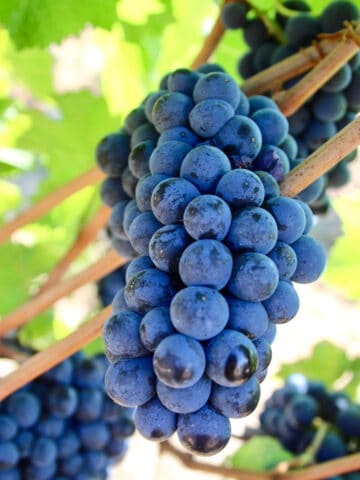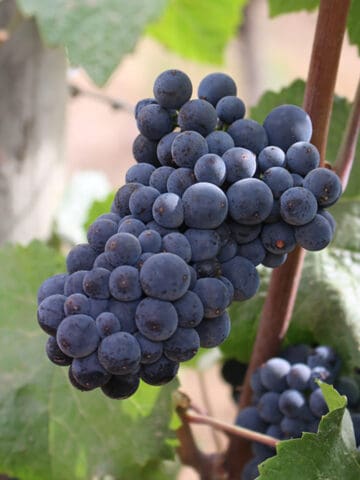They’re bold, full-bodied, and two of the world’s most popular types of red wine. But what sets them apart? Here’s a look at some of the main differences between Cabernet Sauvignon vs Shiraz, to help you choose your next bottle with confidence.

France is home to both the Cabernet Sauvignon and Syrah grape varieties — or Shiraz as it’s referred to in Australia. And both produce big, meaty wines.
While they share these similarities, each has unique characteristics that set them apart, and that have made them two of the most popular red wines among wine drinkers.
Here’s a closer look at their key differences, including flavor profile, aroma, body, and ideal food pairings.


Jump to:
The origin of Cabernet Sauvignon
Cabernet Sauvignon is one of the most recognizable of France’s six renowned Bordeaux red wine grapes (the others include Merlot, Cabernet Franc, Malbec, Petit Verdot, and Carménère).
The Cabernet Sauvignon grape dates back to the 17th century, originating as a cross-pollinated hybrid of Cabernet Franc (a red grape) and Sauvignon Blanc (a white grape).
Fast forward to today, and Cabernet Sauvignon has far surpassed those two varieties in terms of consumption and acres planted. In fact, Cab grapes are the most widely grown in the world.
Top Cabernet Sauvignon wine-producing regions include France, the United States (particularly California and Washington State), Italy, Chile, and South Africa.
The origin of Syrah (or Shiraz)
Syrah/Shiraz also hails from France, albeit a different region from Cabernet Sauvignon. The Syrah grape has its roots along the Northern Rhône valley, and began to gain popularity in the 18th century.
The grape does well in moderate to warmer climates and is now one of the most widely planted varieties of wine grape in the world. Apart from France, Australia, South America, and the United States — especially Washington State — are significant Syrah growing regions.
What’s the difference between Syrah and Shiraz?
You may have noticed that we’ve been using the terms ‘Syrah’ and ‘Shiraz’ interchangeably so far. That’s because to a large extent they are.
For starters, both the Shiraz grape and the Syrah grape are the same variety. The major difference is the region where it’s grown. In many areas including France, the grape and the wine are largely called Syrah. In Australia, where it is the most widely grown grape, it’s commonly referred to as Shiraz.
The grape variety was first introduced in Australia in the 1830s, and while it’s unclear how the term “Shiraz” gained popularity there, it has stuck.
Now the terms are used to represent a style of wine using the Syrah grape. Many winemakers will call a wine Shiraz if it aligns with the type that is produced in warmer regions like Australia. Those produced in moderate climates, such as France, are typically called Syrahs.
That said, the two styles can result in slightly different wine characteristics, which we’ll go over in more detail below.
Note – While previously speculation existed that Shiraz originated near the city of the same name in Persia — modern-day Iran — DNA analysis has since proved its French origin. The area of Shiraz in Iran was also known for wine, but it was a separate style.
Cabernet Sauvignon: Flavor characteristics and aroma

Cabernet Sauvignon wines are often described as being rich in tannins. These natural substances found in grape skins, stems, and seeds add dryness, chalkiness, and astringency or bitterness to wine. That can make it feel grippy as you drink it, as if it sort of sticks to your tongue.
Tannins also contribute to a wine’s finish, during which the flavor lingers and can change even after you swallow it.
If the tannin levels are too high, a wine can feel unpleasantly ‘chewy.’ But mellow tannins can make a wine velvety and smooth. Good Cabernet Sauvignons exhibit these velvety characteristics.
They’re also full-flavored with notes of dark fruit like blackberry, plum, and raspberry. Other common flavor notes are more earthy, such as tobacco and leather.
Black fruit also is also prevalent when it comes to the aroma of Cabernet Sauvignon, particularly for those grown in warmer European regions. You may also get notes of dark chocolate and green peppercorn.
Other aromas can include raspberry, green bell pepper, and graphite.
Syrah/Shiraz: Flavor characteristics and aroma
Syrah is also highly tannic, due in part to their thick grape skins — so like Cabs, they may also feel “grippy” or very dry when you drink them.
Common flavor notes include black fruits, plum, blueberry, peppercorn, black pepper, truffles, and smoke.
Australian Shiraz can be even more tannic and is generally bolder and more fruit-forward than Syrahs. That’s thanks in part to the sunny climates where Shiraz is grown, which allow the fruit to ripen more fully. Conversely, the slightly lower tannins in Syrah can often result in a smoother mouthfeel.
In any case, whether you have a Syrah or a Shiraz, you’re going to get a hefty, rich, flavorful red wine.
Acidity
Acidity plays a large role in how a wine feels and tastes while you drink it.
Highly acidic wines tend to coat the sides of your mouth and can taste bright and tart. Lower-acidity wines will feel smoother and softer when you drink them.
In red wines, acid is important in helping to balance out heavy tannins and higher alcohol levels.
Cabernet Sauvignon
Cabernet Sauvignon grapes are generally medium to high in acidity, depending on where they’re grown. Warmer-climate California Cabernets can be lower in acid than those grown in colder regions like South Africa, for example. That’s because lower temperatures can slow the ripening process, which preserves the grape’s acidity, and reduces natural sugar levels.
Good Cabernets will exhibit a nice balance of acid and tannins. They will also age well, allowing those tannins to smooth out over time.
Syrah/Shiraz
Syrah and Shiraz can differ in the amount of acidity they have. Syrah wine made in cooler regions often has brighter, higher acidity and a bit more tartness.
Shiraz produced in warm climates tends to have more moderate acidity levels, as the grapes ripen for longer on the vine.
Body

Body in wine is closely related to alcohol level. Grapes with higher sugar content produce more alcohol during fermentation, which can help the wine feel richer and more structured. Therefore, wines from warmer-regions tend to seem more full-bodied.
But tannins can also contribute to body. Grippy, tannic wines can feel bigger and heftier than lower tannin reds. Therefore, both Cabs and Syrahs are often described as medium to full-bodied wines. Whereas low-tannin ones like Pinot Noir are often lighter-bodied.
Cabernet Sauvignon
Cabernet Sauvignon typically has a thick, full body and structure. With its high tannins, chewiness, and long finish, it comes across as a hefty wine. Generally, Cabs have medium to high alcohol levels, ranging from about 13% to 14.5% ABV.
Syrah/Shiraz
Syrahs from cooler climates will generally be medium to full-bodied. They may feel dense, but are usually still rounded out and pleasant to drink, especially if aged. These wines will feature mid-to-high alcohol content in the 13–14.5% range.
Warmer-region Shiraz wines will have more alcohol — 14% to 15.5% — as the grapes ripen longer and more fully, resulting in greater sugar levels. Consequently, the wines often feel richer, fruitier, and more full-bodied.
Color

Just as both Syrahs and Cabernets are full of flavor, they are also rich in color.
Cabernet Sauvignons tend to be a deep, dark red, similar to the dark fruits that they resemble. This depth of color also contributes to its overall fullness in body.
Syrah and Shiraz also have a dark color — usually exhibiting a rich, deep ruby red to purple hue. This reflects the black fruit and black pepper notes in their flavor profiles.
Aging
Cabernet Sauvignon
Because Cabernet Sauvignon is high in tannin, these wines tend to age particularly well. Aging the wine will serve to mellow out those tannins over time, making them more velvety and complex.
Although some Cab producers make their wine with the intent that it’s consumed more quickly rather than aged, many high-quality Cabs will age well for up to 10 years.
Syrah/Shiraz
High tannins in Syrah and Shiraz also make them ideal for long-term aging, as those tannins help preserve the wine. And like with Cabs, the tannic qualities will smooth out and the wine will feel softer with age.
Most Syrahs will age well for 5-10 years. Some bigger, fuller Shiraz wines can age even longer, up to 20 years.
Food pairings
It’s no secret that full-bodied red wines go well with red meat. And that’s certainly true with Cab and Syrah.
Cabernet Sauvignon
The richness and heft of Cabernet Sauvignon make it the perfect match for rich high-fat cuts of meat, like Rib Eye and New York Strip Steak. They help bring out the wine’s intense flavors and aromas.
But there are some additional food pairings worth considering. If you’re looking for steak alternatives, try a Cab with roast lamb, rich pastas, meatballs, or earthy vegetables like stuffed mushrooms.

Syrah/Shiraz
Along with steak, Shiraz and Syrah pair well with roasted duck, as well as darker meats like lamb. They also complement spicy foods and grilled meats. Try them with BBQ ribs or grilled steak.
Like Cabs, other good pairings include rich red sauce pasta dishes, stews, and mushrooms.
Price
Because Cabernet Sauvignon is so widely produced, prices for the wine can range wildly. It is possible to find a good bottle in the $20-$25 range. But high quality Cabs will often sell upwards of $50 or more.
Syrah and Shiraz are generally more affordable. While you certainly could shell out more than $100 for a bottle of either, great wines that are meant for immediate consumption can be had for around $20.
If you intend to store some, you may be looking at wines that are in the $25-$35 range and up.
Shiraz vs Cabernet Sauvignon summary
Cabernet Sauvignon
- Primary growing regions: France, United States, Australia
- Worldwide growing acres: 840,000
- Body: Full
- Color: Deep, rich red
- Acidity: Medium
- Tannins: High
- Flavor notes: Blackberry, plum, raspberry, tobacco, leather
- Cost: Tend to be more expensive. $50 and up for a good Cab
Syrah/Shiraz
- Primary growing regions: France, United States, Australia (Shiraz)
- Worldwide growing acres: 470,000
- Body: Medium to full
- Color: Deep red to deep purple
- Acidity: Medium
- Tannins: High
- Flavor notes: Black fruit, plum, blueberry, peppercorn, truffles, and smoke
- Cost: $15-$20 for ready-to-drink Syrah/Shiraz; $25-$35 and up for higher quality
If you’re into full-bodied, dry red wines, chances are you’ll enjoy both Cabs and Syrah (or Shiraz). If you’re not too familiar with either, try a few. Over time, you’ll get used to the differences in each type. After all, sampling different wines is what makes learning about them so much fun. And you may find ones that you go back to again and again.
More wine answers
Get answers to more frequently asked questions about wine. Check out these posts.






Leave a Reply